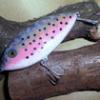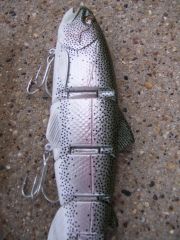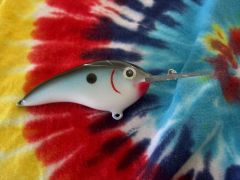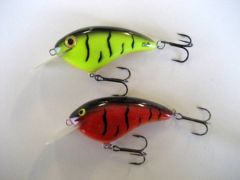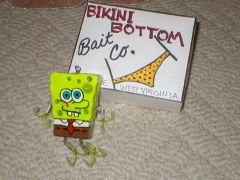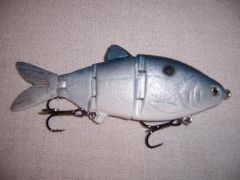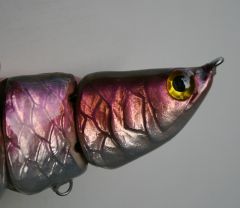-
Posts
3,867 -
Joined
-
Last visited
-
Days Won
23
Content Type
Profiles
Articles
TU Classifieds
Glossary
Website Links
Forums
Gallery
Store
Everything posted by diemai
-
-
@ akjohno At first , welcome to TU ! Certainly your lures have to be as symetrical as possible , viewed from top/belly and from front/rear . The larger the lure is , the more it would forgive little inaccuracy about the symetry , but always try to achieve the possible best . Indeed there are some configurations about linetie placement and bib size and angle , that simply would not let a lure perform well . Like Dave has said already , best would be , if you'd post a few pictures of your lure(s) , so I am sure , you'd get a lot of answers in here about what might possibly go wrong ! greetz:yay: , diemai
-
Hope , that you 've enjoyed the party:popcorn: ! best wishes , diemai
-
-
@ matt duarte It seems to me , that the lure terminology is a bit confusing , even around the United States only , not to talk about adding Europe to the game ! I'd say , that a glider bait and a "walk-the-dog" bait have about the same action , only the glider bait sinks and runs under the surface . Naturally , depending on each lure model , it can dart to ANY direction , whereas the topwater obviously only darts left/right . To complicate matters more , in Europe we do use English terms for such different styles of lures , but these are obviously not the same like yours over there . A sinking glider we would simply call a "jerkbait" , a "walk-the-dog" topwater lure a "stickbait" . The lipped minnow baits , that you call "jerkbaits" over there , we would call "twitchbaits" or just "wobbler"(general term for lipped lures) . All a bit confusing:eek:! Greetz , diemai
-
-
-
-
-
-
@ Them Muskie Lures Really depends on the length of bait , since you would need overlength drill bits to put a hole through the lurebody . Even when utilizing such bits , it still requires an extremely accurate working process . Possibly don't use a kinda wood with pronounced hard and soft grain portions , since these are more prone to drill bit wandering , take a wood of equal hardness all the way through . And I would drill the hole first , when the blank is still in a rectangular condition , not rounded at all . Also I would drill it from eiter side to meet in center , since this way the drill bit only has a 50% chance to wander off center . Requires very accurate marking , hole centering with an awl and perfectly angled aligning of the workpiece in the drillpress' vise . Drill at high RpM and very low feed to possibly prevent wandering . If the bit has still gotten off center , thus the two bores don't meet , the only thing to do is trying making the holes a little bigger in diameter , hoping , that they still would meet . They'd be filled up with epoxy during later assembly , anyway . Grind a small point onto your wire shaft to pass throug the hole easier . To make the rear eye , leave the very tail end of lur a bit straight , not fully rounded , extend the entry of the wire hole to a bit more than double diameter for about 1/3" depth and than bend the rear eye around a nail , fixed vertically in a vise , about 1/4" to 1/3" away from the tail end . Now wrap a closure coil around wire shaft right down to the tail , meeting the wood body and snip tag end off. Use some fast setting epoxy glue to fill up extension of wire hole and to surround the closure coil . Turn workpiece in your hand , so glue sets equally around coil . After recommended curing time you can trim that "glue plug" flush and well-transitioned to body outline with "Dremel" router bits and by filing/sanding . This way that ugly wire coil at the tail of lure won't be visible anymore . good luck , diemai
-
@ pikeman I think , that a deep diving lure without a big lip is quite paradoxical . I might probably use lures like the "Rapala Countdown" lure style in your case , also because of the depth changes , that you have mentioned , also they do not wiggle too exaggerated . But I surely prefer a long lipped diver , since it won't snag up as much , just stopping the retrieve , as it bumps the bottom . I have recently made some lures(partly still unfinished) , where I believe to have found out , that a wider lip somehow slows down the wiggle . So maybe try using the typical long diving lip , but make it not as narrow as usual , ESPECIALLY at its base(where it enters the body) . I have uploaded a small , lathe-turned crankbait the other day , about 2 1/2" long(without lip) , that I was very surprised about having a tight , high frequency wobble without pronounced tail-swings . I am almost sure , if I had used less buoyant wood for it , it would have got down to 16 feet , maybe also increase lip size a bit . Its the bottom lure on the including picture . good luck:yay: , diemai
-
@ northsea These lures are looking quite similar to "Tasmanian Devils" , but I guess , that they are way heavier , since the "Devils" only have a lead tubing insert , whereas wings and body are of transparent plastic . The German mail order shop HAKUMA ihr Spezialist für Köder, Kunstköder, Meeresangeln, Raubfisch angeln, Pilker, Wobbler, Fischen, Bleiguss, Formen, Ruten, Rollen, Dorsch angeln, Leng angeln in Norwegen, Dänemark, Hitra sells a system based on silicone sheets , that are supposed to be used to duplicate lead lures to make clones of these . In brief the original lure is clamped between the two silicone plates in a special frame and then placed in boiling water to cure the mold , said to be good for many casts , depending on size and weight of lures . Haven't used it before , just wanted to mention this possibility . On their start page go to "shop" , after on the left bar click on "Bleigussformen und Zubehör" and browse through , you should find pics of it there . Sorry , no English site version available ! greetz , diemai
-
@ mark poulson Thanks , Mark I usually do this , but on one particular German site I use the linking via Email , so I will stop doing this as well and type it in again after deleting the mail . I have ever bbeen cautious about unknown senders of Emails , anyway , don't open them up ! greetz:yay: , Dieter
-
-
Good luck for you , Mark , I am anxious about that might happen to me one day ! Greetz , Dieter
-
@ Them Muskie Lures Utilize search function for threads "Drilling thru-wire" and "Thru Wire Technique" , you may get some input in there . good luck , diemai
-
@ muskietom51 Do you intend to pour the molten lead into holes in the belly of your lure ? I have heard about this method from some Dutch and Belgian guys , but haven't done it myself . They'd drill holes after estimated diameter and depth(or known by experience)and pour lead in . Now they rig the lure and tank-test it , off course it should sink more or less fast and also level . Now they drill out as much lead off the bores as required to achieve desired sink rate and level . I do it different : I'd rig the lure with hooks and a leader substitute(bigger paperclip) and first hang a kinked stripe of roofing lead sheet(approx. 3/5" X 7") onto the belly hook and test in a water bucket . I'd shorten that stripe , until desired sink rate is achieved . Now I use the stripe as a stencil to cut out a second stripe of same size . Now I cut first stripe apart at about 3/5 to 4/7 of length and roll the two parts up to real tight rolls . I'd stick these onto the belly fore and aft with plastic cable insulation tape to check for proper sink level . Have to tinker a bit with locations , also shortening lead rolls probably . This is why I have cut a second stripe , so that I would have spare material , in case I cut one too short . When I'm satisfied , I'd comprime the rolls a bit with a hammer(under constant rolling to keep 'em round , first one side , after the other side) , drill approbiate holes at the previously marked locations and glue in the weights . The sink rate you can easily estimate in that water bucket , but remember , that drilling weight holes and the final topcoats would render the sinkrate a little faster , since the lure gets a little heavier . For example , if you want a real slow sinking lure , you weigh it in your bucket still with its back sticking out just a little fraction , the finished bait would then sink quite slow . Off course , you could do it in a very similar way as well with mold-cast cylindrical weights . After having determined about the weighting this way , I glue the ballast in , period , so no need to seal any holes , 'cause my bait won't hit the waters again unless completely done ! good luck:yay: , diemai
-
Off course , me stupid , Dave meant an aluminium lip:o ! I use such homemade lips of about mentioned thickness on some of my own crankbaits , no problems so far , not even with a 66" silure , that a friend of a friend caught on one of my lures in Spain . I'd cut them out with shears or with a jigsaw and file/grind them to outer shape . Bending is done in a vise . Those aluminium lips don't look too beautiful , but you can easily bend them to alter lure action . sorry for misunderstanding:) , diemai
-
@ Vodkaman I would not trust aluminium wire even not as thick as that one . I have a lot of 1,0 mm aluminium welding wire , the guy at the place , where I buy my stainless welding wire , gave me for free , I am only using it as hooks for hanging lures in my drying rack . It tears a lot easier than SSt of same dia. , when twisting it or bending it up and down . greetz , diemai
-
This is sick.........I'm running away frequently from the living room to the PC screen , when my wife is watching Sponge Bob every evening...........open up TU gallery site and.................aarrgghh:eek::eek::eek: ! Still a nice work and idea:yes:.........but in my point of view.......sick ! Not everyone is fond of nerve-wrecking toons , greetz , diemai
-
@ finlander Lures with deep diving , pointing forward lips would spin with a line tie on the nose , simply because the leverage of the water pressure around the towpoint and on the lip is too high , and the pull of the retrieved line is not strong enough to force the lure back . Also the ballast weights and the physical sideward stability of the lure in the water can not overcome this leverage force anymore , so the lure spins . If now the linetie is placed closer to the tip of the lip , or in other words , right on the lip , the strength of leverage becomes less , the lure but would still "want" to lay on it's side to spin , but the force of the retrieved line is now sufficient to pull it back into opposite direction , where it tends to lay on it's side again , so same thing again.........the lure wobbles ! Concerning the stainless steel lip , that you mentioned , I assume , that you mean these large triangular and cupped ones available in some component stores ? These are supposed to be screwed under the chin of the lures . If this is the case , I am very sure , that a lure of 12" to 14" would carry such lip easily , but it depends on the buoancy of the wood used and also the volume of the lureblank . Maple , oak and similar maybe a bit too heavy , but pine and basswood should be OK . The lure might only hang head-down a bit at rest , but if trolling , not casting , it should not be a problem , since it would be headache to cast such a front-weighted lure , it would often leader-tangle . Many times such heavy metal lips render extra ballast weights to be not neccessary . good luck:yay: , diemai
-
-
-



